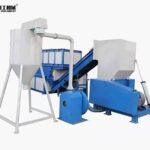Plastic recycling shredder is specialized machines engineered to break down plastic materials into smaller, manageable pieces, typically referred to as flakes. The shredded plastic is then sent to granulators, washers, or extrusion machines for further recycling, reducing the need for virgin plastic production. The primary goal of these machines is to streamline the recycling process, making it more efficient and cost-effective while minimizing environmental impact.
How Does A Plastic Recycling Shredding Machine Work?
- Feeding: Plastic waste is fed into the shredder’s hopper, either manually or via conveyor systems.
- Shredding: Rotating blades or hammers break down the plastic into smaller particles. The size of the output (known as “flake” or “granule”) depends on the shredder’s design and screen settings.
- Discharge: The shredded plastic exits the machine through a discharge chute, ready for further processing.
Types of Plastic Recycling Shredder
- Single-Shaft Shredders
Ideal for light to medium-duty applications, single-shaft shredders use a rotating blade with stationary counter blades to cut plastic. They excel at processing films, bags, and soft plastics, producing uniform flakes for recycling. - Dual-Shaft Shredders
Dual-shaft models feature two counter-rotating shafts with interlocking blades. These shredders are built for heavy-duty tasks, such as breaking down bulky items like buckets, crates, and automotive parts. Their aggressive cutting action ensures efficient size reduction even for thick or rigid plastics.
Benefits of Investing in a Plastic Shredder Equipment
- Cost Savings
Recycling in-house reduces raw material expenses. Shredded plastic pellets can be reused in production, lowering procurement costs. - Environmental Impact
By diverting plastic from landfills, shredders cut greenhouse gas emissions and reduce the demand for fossil fuel-derived plastics. - Versatility
Plastic recycling shredder can process various plastic types, making them adaptable to changing waste streams and production needs.
Factors to Consider When Choosing A Plastic Shredder Machine
- Material Type
Different plastics have varying properties. Hard plastics like HDPE require more robust shredders, while soft films may need specialized cutting systems to avoid tangling and jamming. - Output Size
The intended application of the shredded plastic determines the required output size. Granulators may be needed if very fine particles are required. - Throughput Capacity
This refers to how much plastic the shredder can process in a given time. Facilities with high volumes of plastic waste should opt for heavy-duty models with high throughput rates. - Power Consumption
Energy efficiency is crucial to keep operational costs low. Modern plastic recycling shredder often include energy-saving features such as automatic shut-off and optimized motors.



